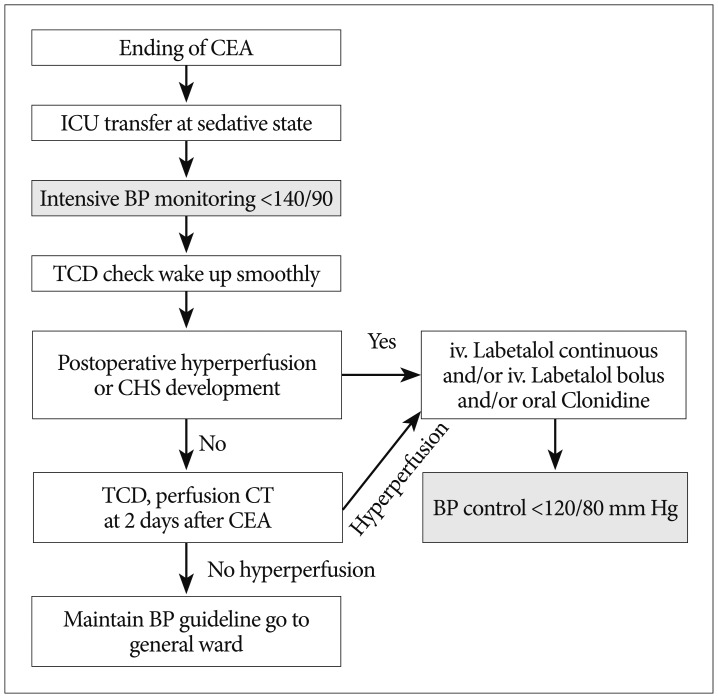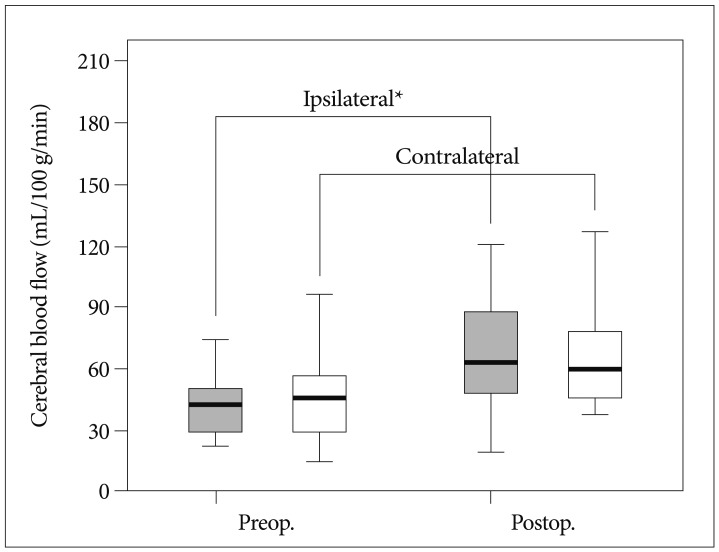J Korean Neurosurg Soc.
2013 Sep;54(3):159-163. 10.3340/jkns.2013.54.3.159.
Post-Carotid Endarterectomy Cerebral Hyperperfusion Syndrome : Is It Preventable by Strict Blood Pressure Control?
- Affiliations
-
- 1Department of Neurosurgery, Seoul National University Hospital, Seoul, Korea.
- 2Department of Neurosurgery, Seoul National University Bundang Hospital, Seongnam, Korea.
- 3Department of Neurosurgery, SMG-SNU Boramae Medical Center, Seoul, Korea. nslee@snu.ac.kr
- 4Department of Neurosurgery, Seoul National University College of Medicine, Seoul, Korea.
- KMID: 2190892
- DOI: http://doi.org/10.3340/jkns.2013.54.3.159
Abstract
OBJECTIVE
Cerebral hyperperfusion syndrome (CHS) is a serious complication after carotid endarterectomy (CEA). However, the prevalence of CHS has decreased as techniques have improved. This study evaluates the role of strict blood pressure (BP) control for the prevention of CHS.
METHODS
All 18 patients who received CEA from February 2009 through November 2012 were retrospectively reviewed. All patients were routinely managed in an intensive care unit by a same protocol. The cerebral perfusion state was evaluated on the basis of the regional cerebral blood flow (rCBF) study by perfusion computed tomography (pCT) and mean velocity by transcranial doppler (TCD). BP was strictly controlled (<140/90 mm Hg) for 7 days. When either post-CEA hyperperfusion (>100% increase in the rCBF by pCT or in the mean velocity by TCD compared with preoperative values) or CHS was detected, BP was maintained below 120/80 mm Hg.
RESULTS
TCD and pCT data on the patients were analyzed. Ipsilateral rCBF was significantly increased after CEA in the pCT (p=0.049). Post-CEA hyperperfusion was observed in 3 patients (18.7%) in the pCT and 2 patients (12.5%) in the TCD study. No patients developed clinical CHS for one month after CEA. Furthermore, no patients developed additional neurological deficits related to postoperative cerebrovascular complications.
CONCLUSION
Intensive care with strict BP control (<140/90 mm Hg) achieved a low prevalence of post-CEA hyperperfusion and prevented CHS. This study suggests that intensive care with strict BP control can prevent the prevalence of post-CEA CHS.
Keyword
MeSH Terms
Figure
Reference
-
1. Abou-Chebl A, Reginelli J, Bajzer CT, Yadav JS. Intensive treatment of hypertension decreases the risk of hyperperfusion and intracerebral hemorrhage following carotid artery stenting. Catheter Cardiovasc Interv. 2007; 69:690–696. PMID: 17377975.
Article2. Adhiyaman V, Alexander S. Cerebral hyperperfusion syndrome following carotid endarterectomy. QJM. 2007; 100:239–244. PMID: 17307751.
Article3. Bernstein M, Fleming JF, Deck JH. Cerebral hyperperfusion after carotid endarterectomy : a cause of cerebral hemorrhage. Neurosurgery. 1984; 15:50–56. PMID: 6472594.
Article4. Biller J, Feinberg WM, Castaldo JE, Whittemore AD, Harbaugh RE, Dempsey RJ, et al. Guidelines for carotid endarterectomy : a statement for healthcare professionals from a special writing group of the Stroke Council, American Heart Association. Stroke. 1998; 29:554–562. PMID: 9480580.5. Bouri S, Thapar A, Shalhoub J, Jayasooriya G, Fernando A, Franklin IJ, et al. Hypertension and the post-carotid endarterectomy cerebral hyperperfusion syndrome. Eur J Vasc Endovasc Surg. 2011; 41:229–237. PMID: 21131217.
Article6. Coutts SB, Hill MD, Hu WY. Hyperperfusion syndrome : toward a stricter definition. Neurosurgery. 2003; 53:1053–1058. discussion 1058-1060. PMID: 14580271.7. De Rango P. Cerebral hyperperfusion syndrome : the dark side of carotid endarterectomy. Eur J Vasc Endovasc Surg. 2012; 43:377. PMID: 22289610.
Article8. Greenberg MS. Handbook of Neurosurgery. ed 7. Florida: Thieme;2010. p. 1152.9. Henderson RD, Phan TG, Piepgras DG, Wijdicks EF. Mechanisms of intracerebral hemorrhage after carotid endarterectomy. J Neurosurg. 2001; 95:964–969. PMID: 11765840.
Article10. Holm J, Nilsson U, Waters N, Waters S, Jonsson O. Production of free radicals measured by spin trapping during operations for stenosis of the carotid artery. Eur J Surg. 2001; 167:4–9. PMID: 11213819.11. Hosoda K, Kawaguchi T, Shibata Y, Kamei M, Kidoguchi K, Koyama J, et al. Cerebral vasoreactivity and internal carotid artery flow help to identify patients at risk for hyperperfusion after carotid endarterectomy. Stroke. 2001; 32:1567–1573. PMID: 11441203.
Article12. Jørgensen LG, Schroeder TV. Defective cerebrovascular autoregulation after carotid endarterectomy. Eur J Vasc Surg. 1993; 7:370–379. PMID: 8359291.
Article13. Kawamata T, Okada Y, Kawashima A, Yoneyama T, Yamaguchi K, Ono Y, et al. Postcarotid endarterectomy cerebral hyperperfusion can be prevented by minimizing intraoperative cerebral ischemia and strict postoperative blood pressure control under continuous sedation. Neurosurgery. 2009; 64:447–453. discussion 453-454. PMID: 19240606.
Article14. Kim DE, Choi SM, Yoon W, Kim BC. Hyperperfusion syndrome after carotid stent-supported angioplasty in patients with autonomic dysfunction. J Korean Neurosurg Soc. 2012; 52:476–479. PMID: 23323169.
Article15. Komoribayashi N, Ogasawara K, Kobayashi M, Saitoh H, Terasaki K, Inoue T, et al. Cerebral hyperperfusion after carotid endarterectomy is associated with preoperative hemodynamic impairment and intraoperative cerebral ischemia. J Cereb Blood Flow Metab. 2006; 26:878–884. PMID: 16280980.
Article16. Lagreze HL, Levine RL, Sunderland JS, Nickles RJ. Pitfalls of regional cerebral blood flow analysis in cerebrovascular disease. Clin Nucl Med. 1988; 13:197–201. PMID: 3260164.
Article17. Lee CH, Jung YS, Yang HJ, Son YJ, Lee SH. An innovative method for detecting surgical errors using indocyanine green angiography during carotid endarterectomy : a preliminary investigation. Acta Neurochir (Wien). 2012; 154:67–73. discussion 73. PMID: 22068716.
Article18. Maas MB, Kwolek CJ, Hirsch JA, Jaff MR, Rordorf GA. Clinical risk predictors for cerebral hyperperfusion syndrome after carotid endarterectomy. J Neurol Neurosurg Psychiatry. 2013; 84:569–572. PMID: 23243262.
Article19. Meyers PM, Higashida RT, Phatouros CC, Malek AM, Lempert TE, Dowd CF, et al. Cerebral hyperperfusion syndrome after percutaneous transluminal stenting of the craniocervical arteries. Neurosurgery. 2000; 47:335–343. discussion 343-345. PMID: 10942006.
Article20. Miyamoto N, Naito I, Takatama S, Shimizu T, Iwai T, Shimaguchi H. Urgent stenting for patients with acute stroke due to atherosclerotic occlusive lesions of the cervical internal carotid artery. Neurol Med Chir (Tokyo). 2008; 48:49–55. discussion 55-56. PMID: 18296872.
Article21. Morrish W, Grahovac S, Douen A, Cheung G, Hu W, Farb R, et al. Intracranial hemorrhage after stenting and angioplasty of extracranial carotid stenosis. AJNR Am J Neuroradiol. 2000; 21:1911–1916. PMID: 11110546.22. Naylor AR, Evans J, Thompson MM, London NJ, Abbott RJ, Cherryman G, et al. Seizures after carotid endarterectomy : hyperperfusion, dysautoregulation or hypertensive encephalopathy? Eur J Vasc Endovasc Surg. 2003; 26:39–44. PMID: 12819646.
Article23. Ogasawara K, Sakai N, Kuroiwa T, Hosoda K, Iihara K, Toyoda K, et al. Intracranial hemorrhage associated with cerebral hyperperfusion syndrome following carotid endarterectomy and carotid artery stenting : retrospective review of 4494 patients. J Neurosurg. 2007; 107:1130–1136. PMID: 18077950.
Article24. Ogasawara K, Yukawa H, Kobayashi M, Mikami C, Konno H, Terasaki K, et al. Prediction and monitoring of cerebral hyperperfusion after carotid endarterectomy by using single-photon emission computerized tomography scanning. J Neurosurg. 2003; 99:504–510. PMID: 12959438.
Article25. Pennekamp CW, Tromp SC, Ackerstaff RG, Bots ML, Immink RV, Spiering W, et al. Prediction of cerebral hyperperfusion after carotid endarterectomy with transcranial Doppler. Eur J Vasc Endovasc Surg. 2012; 43:371–376. PMID: 22264422.
Article26. Reigel MM, Hollier LH, Sundt TM Jr, Piepgras DG, Sharbrough FW, Cherry KJ. Cerebral hyperperfusion syndrome : a cause of neurologic dysfunction after carotid endarterectomy. J Vasc Surg. 1987; 5:628–634. PMID: 3560356.
Article27. Ricotta JJ, Aburahma A, Ascher E, Eskandari M, Faries P, Lal BK. Updated Society for Vascular Surgery guidelines for management of extracranial carotid disease. J Vasc Surg. 2011; 54:e1–e31. PMID: 21889701.
Article28. Ricotta JJ, Aburahma A, Ascher E, Eskandari M, Faries P, Lal BK. Updated Society for Vascular Surgery guidelines for management of extracranial carotid disease : executive summary. J Vasc Surg. 2011; 54:832–836. PMID: 21889705.
Article29. Schroeder T, Sillesen H, Sørensen O, Engell HC. Cerebral hyperperfusion following carotid endarterectomy. J Neurosurg. 1987; 66:824–829. PMID: 3572512.
Article30. Solomon RA, Loftus CM, Quest DO, Correll JW. Incidence and etiology of intracerebral hemorrhage following carotid endarterectomy. J Neurosurg. 1986; 64:29–34. PMID: 3941347.
Article31. Soong CV, Young IS, Hood JM, Rowlands BJ, Trimble ER, Barros D'Sa AA. The generation of byproducts of lipid peroxidation following carotid endarterectomy. Eur J Vasc Endovasc Surg. 1996; 12:455–458. PMID: 8980437.
Article32. Sundt TM Jr, Sharbrough FW, Piepgras DG, Kearns TP, Messick JM Jr, O'Fallon WM. Correlation of cerebral blood flow and electroencephalographic changes during carotid endarterectomy : with results of surgery and hemodynamics of cerebral ischemia. Mayo Clin Proc. 1981; 56:533–543. PMID: 7266064.
- Full Text Links
- Actions
-
Cited
- CITED
-
- Close
- Share
- Similar articles
-
- Hyperacute hyperperfusion intracerebral hemorrhage complicating carotid endarterectomy: A case report
- A Case of Post-Carotid Endarterectomy Hyperperfusion Syndrome
- Delayed Cerebral Hyperperfusion Syndrome Three Weeks after Carotid Artery Stenting Presenting as Status Epilepticus
- Fatal Propofol Infusion Syndrome Associated with Refractory Partial Status Epilepticus in a Patient with Cerebral Hyperperfusion Syndrome
- Hyperperfusion Syndrome after Carotid Stent-Supported Angioplasty in Patients with Autonomic Dysfunction




